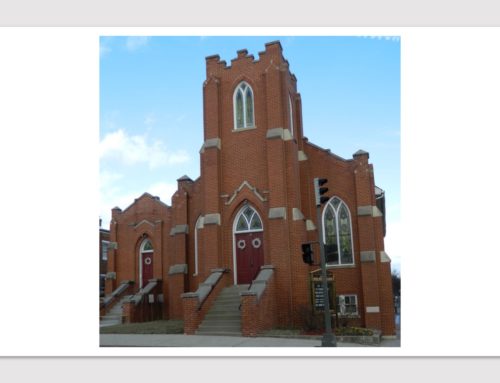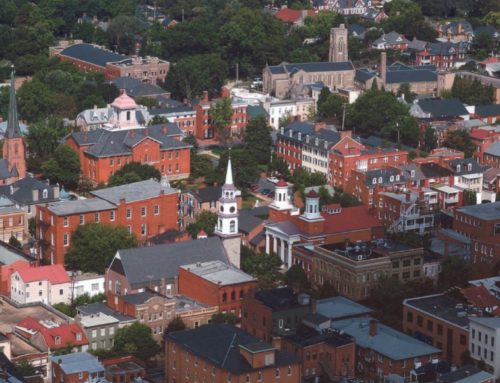Excerpt from the Frederick News-Post:
In less than two weeks, Frederick’s Historic Preservation Commission will decide the fate of the Birely Tannery building.
Passionate opinions both for and against the demolition of the building rang out across a packed City Hall boardroom Thursday in the last of four public workshops dedicated to the decision.
The demolition request stems from plans to construct a multimillion-dollar hotel and conference center at 200-212 E. Patrick St. The commissioners determined in July that the early 20th-century brick tannery building and surrounding archaeological site are contributing resources to the Frederick Town Historic District, thus halting immediate demolition plans.
The proposed design includes demolition of the tannery building but incorporates rehabilitation of the old Frederick Trolley building, which most recently housed The Frederick News-Post’sheadquarters.
The developers, architects and other project partners are tasked with proving that demolition of the tannery is the only logical way to construct the hotel at that site and that all possible alternatives to preservation have been exhausted. They must also provide an alternative plan for preserving the historic elements of the site.
Members of the Historic Preservation Commission, who are tasked with making the final decision on the demolition, listened intently to the comments for nearly an hour and a half at the beginning of Thursday’s workshop and an additional 30 minutes at the end. In between, developers, architects and city officials presented details of the project plans. Their testimonies included a detailed breakdown of the expected economic impact of the hotel project — sans tannery building — and rough plans for how the developers plan to display the history of the tanning industry without the building.
Commission Chairman Dan Lawton said after the 3½-hour workshop that the commission will be ready to vote on the demolition at its next meeting on Sept. 14.
Opposing viewpoints
A number of people who commented at Thursday’s meeting spoke in favor of demolishing the tannery, mostly as a means of allowing the hotel project to move forward. Some spoke against it in the name of preserving what is reportedly one of the last standing tannery buildings in Maryland.
The proponents included representatives from large companies in Frederick that spoke in favor of a downtown hotel to host local conferences, some historic preservation representatives, members of the local tourism industry and business community, and representatives from the Downtown Frederick Partnership and the Frederick County Chamber of Commerce, among others.
George Delaplaine, a descendant of the Birely family that owned the tannery, said he and his family believed the demolition was warranted 30 years ago after a flood severely damaged the structure and many of its historic elements. The structure has also been damaged in several fires and does not have much of its original historic charm.
David Price, executive director of the National Museum of Civil War Medicine, said he has dedicated his career to studying and preserving history and believes demolition of the tannery is something that is needed to preserve what was there in a real way.
“Right now, when people look at the building, they instinctually turn away from the site and they have no idea of what the structure was or what it was used for. They just see a boarded-up building,” he said. “This project incorporates and celebrates the story of the tanning industry and the building. It will literally bring those stories back to life and preserve its history.”
The opponents of the demolition have a different take on the building’s significance.
Scott Winnette, the most recent former Historic Preservation Commission chairman, encouraged the commissioners to do what he believes is the right thing for historic preservation and deny the demolition. He asserted that the developers will find a way to develop the hotel anyway.
“Do not permit demolition and they will find a way forward,” he said.
Kelly Berliner, a Frederick resident and archaeologist, said she was frustrated with the way many of the commenters argued that the demolition of the tannery would halt the entire hotel project.
“It seems like most people are seeing this as the hotel versus the tannery, and this juxtaposition is just false,” she said. “It perpetuates a really negative association [that] historic preservation is standing in the way of development, and it’s simply not true.”
Berliner added that she believes creative ways exist to maintain or move the tannery as an alternative to tearing it down.
Other opponents of the demolition who have spoken up since before the first workshop even commenced have argued that the tannery building is historic and criticized the developers for not incorporating it into the design that was chosen.
Several have also criticized the process, which included the work of a hotel advisory committee that did not include any representatives from the historic preservation community.
Officials with the Maryland Historical Trust also found that the tannery building and archaeological site belong on the National Register of Historic Places.
Members of the public will have another chance to comment before the commission votes on the demolition request on Sept. 14.
Justifying the request
Richard Griffin, the city’s director of economic development, explained that the hotel proponents need to meet only one of three criteria to justify demolition of the tannery.
He said they have met two — that keeping the building in its current spot would be a deterrent to a major improvement for the area and that it would not be in the best interest of the community. He said the developers have never tried to prove that keeping the building would create undue stress on the owner, which is the third one.
Griffin said the developers, Plamondon Hospitality Partners, looked at the site and the project “up and down” before arriving at the current design.
“There are occasionally times where a project like this comes along and it’s in the best interest of the community to move forward and maintaining [the structure] would be a deterrent,” he said.
Griffin also said the hotel project is expected to have a $25 million economic impact on the area and that the city, county and state tax dollars set to go into the project are all expected to be paid back over time.
Griffin and several of the public commenters who spoke in favor of the project Thursday pointed out that the tannery building and the former News-Post building have both been vacant for years with no efforts to rehab them.
Pete Plamondon Jr., co-president of Plamondon Hospitality Partners, and architects with Peter Fillat Architects and Bates Architects also offered some examples of how the developers may incorporate the historic elements of the tanning industry into the project. The examples included incorporating leather goods in the walls and on the floors and large windows that look out over the area that was once the site of tanning in the city.
“It invites people to step on over, feel the architecture, and the surroundings of what Frederick, Maryland, is all about,” Plamondon said.
Beyond that, though, Plamondon and the architects said they want to include input from the historic preservation commissioners on how to best preserve that history.
“We didn’t want to be too presumptuous coming forward with all kinds of ideas,” said Jim Mills, an architect with Bates Architects, referring to the fact that the tannery building demolition is not approved yet.
The commissioners argued that having more solid plans or ideas in place before the vote would help them make the decision, though.
“It kind of puts us in a Catch-22 situation,” Lawton said. “On the one hand, we don’t want to presume, but on the other hand, we have no idea what those steps may be.”



